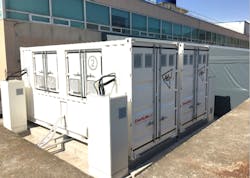H2, Inc. launches 20-MWh Vanadium Redox Flow Battery Storage project in California
Energy storage solutions firm H2, Inc launched a 20MWh vanadium redox flow battery (VRFB) energy storage project in northern California in December.
H2 says the 20-MWh system will be the world’s largest VRFB project, which uses a modular approach with 100% pre-built VRFB modules. It is expected to be the largest VRFB built in the US.
The system will be deployed at an existing gas peaker plant in California and is expected to complete by the end of 2023. Once the pilot phase is successful, H2 intends to begin commercial operation in the California power grid.
The project consortium includes one of the largest state-run generation companies in Korea and a national research institute. It is financially supported by the Korean government.
H2, Inc's Founder and CEO, Dr. Shin Han said, “California is a perfect testbed for large-scale VRFB to replace traditional gas peakers taking great majority of power generation in the state. Since California is a frontrunner in carbon neutrality movements to overcome global climate change, the 20MWh VRFB project is going to be a significant milestone for many states in the US and other following regions with similar targets. This monumental project will show how VRFB is able to substitute for fossil-fueled power plants and optimize power grid crowded with increasing renewable energy.”
About the Author
EnergyTech Staff
Rod Walton is head of content for EnergyTech.com. He has spent 17 years covering the energy industry as a newspaper and trade journalist.
Walton formerly was energy writer and business editor at the Tulsa World. Later, he spent six years covering the electricity power sector for Pennwell and Clarion Events. He joined Endeavor and EnergyTech in November 2021.
He can be reached at [email protected].
EnergyTech is focused on the mission critical and large-scale energy users and their sustainability and resiliency goals. These include the commercial and industrial sectors, as well as the military, universities, data centers and microgrids.
Many large-scale energy users such as Fortune 500 companies, and mission-critical users such as military bases, universities, healthcare facilities, public safety and data centers, shifting their energy priorities to reach net-zero carbon goals within the coming decades. These include plans for renewable energy power purchase agreements, but also on-site resiliency projects such as microgrids, combined heat and power, rooftop solar, energy storage, digitalization and building efficiency upgrades.
